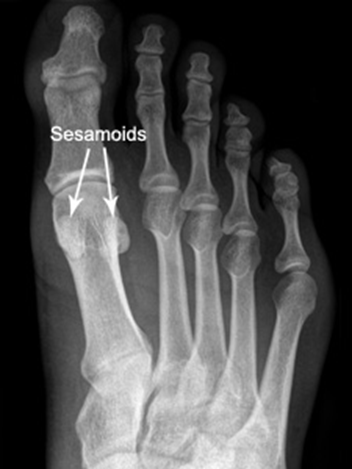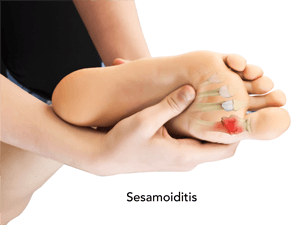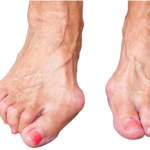What is Sesamoiditis?
Sesamoiditis is a common foot condition that affects the sesamoid bones, two small, pea-shaped bones located beneath the base of the big toe. These tiny bones play a crucial role in the proper functioning of your foot, particularly when you push off the ground during walking or running.

Causes of Sesamoiditis
Sesamoiditis occurs when the sesamoid bones become inflamed or injured due to various reasons, such as:
- Overuse: Repetitive activities that put excessive pressure on the sesamoid bones, like running and dancing.
- High-Impact Sports: Sports that involve rapid direction changes or jumping, which can stress the foot.
- Foot Structure: High arches or excessive foot pronation (rolling inward) can contribute to sesamoiditis.
- Footwear: Improper or ill-fitting shoes that don’t provide enough support can increase the risk.
- Injury: A direct injury or trauma to the sesamoid bones can lead to inflammation.
Symptoms
Common symptoms of sesamoiditis include:
- Pain: Persistent pain beneath the big toe, which can worsen during activity.
- Swelling: Swelling around the affected area.
- Limited Range of Motion: Difficulty bending or straightening the big toe.
- Bruising: Some individuals may experience bruising.
Diagnosis and Treatment
If you suspect you have sesamoiditis, it’s essential to consult a foot specialist, such as Mr Mike Barrett. They will perform a thorough examination, which may include:
- Physical Examination: To assess your symptoms and mobility.
- Imaging: X-rays or other imaging tests to visualise the sesamoid bones.
Treatment Options
Treatment for sesamoiditis typically involves:
- Rest: Reducing or avoiding activities that worsen the condition.
- Icing: Applying ice to the affected area to reduce swelling.
- Footwear: Wearing supportive, cushioned shoes with insoles or custom orthotics.
- Padding/Taping: Padding the affected area or taping the big toe to relieve pressure.
- Medication: Over-the-counter pain relievers or anti-inflammatories (under the guidance of a healthcare provider).
- Physical Therapy: Stretching and strengthening exercises to improve foot function.
- Custom Orthotics: In some cases, custom-made shoe inserts may be prescribed.
Surgical Intervention
If conservative treatments do not provide relief, surgical removal of the sesamoid bone(s) may be considered. Mr Mike Barrett will discuss the risks and benefits of this procedure with you.
Prevention
To reduce the risk of sesamoiditis, consider these preventive measures:
- Choose appropriate footwear for your activities.
- Gradually increase the intensity of physical activities.
- Maintain a healthy body weight to reduce pressure on your feet.
- Stretch and strengthen your calf muscles and the muscles around your big toe.
Conclusion
Sesamoiditis is a manageable condition, and with proper care and treatment, most individuals can return to their regular activities without pain. If you’re experiencing foot pain or suspect you have sesamoiditis, don’t hesitate to reach out to a foot specialist for a thorough evaluation and personalized treatment plan.
Remember, early intervention and proactive foot care are essential for maintaining your foot health and overall well-being.
For more information or to schedule a consultation, contact Mr Mike Barrett’s team.
Last modified: October 10, 2023







